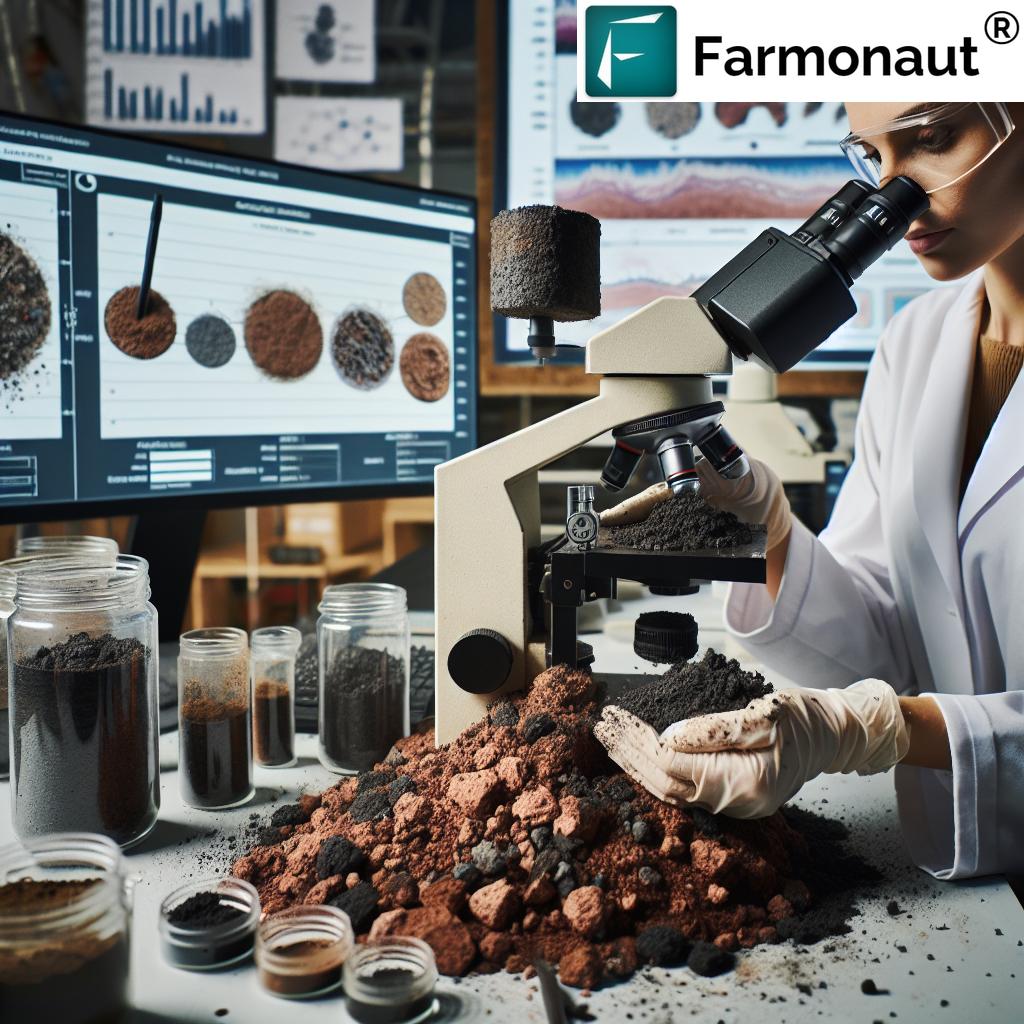Revolutionizing Soil Remediation: Biochar’s Sustainable Solution for Abandoned Mine Reclamation in Western America
“Biochar, made from local vegetation, can reduce soil acidity and metal bioavailability in up to 100% of tested mine-affected areas.“
In the realm of sustainable land management practices, we at Farmonaut are excited to explore groundbreaking agronomy research that is transforming the landscape of abandoned mine reclamation in Western America. As we delve into this innovative approach to soil restoration, we’ll uncover how biochar, a seemingly simple substance, is revolutionizing environmental soil science and paving the way for improved crop production systems in some of the most challenging environments.
The Challenge of Abandoned Mines in Western America
The Western United States is home to a rich mining history, but this legacy has left behind a complex environmental challenge. Thousands of abandoned mine sites dot the landscape, each posing significant risks to the surrounding ecosystem. These sites are often characterized by:
- Heavy metal contamination in soil
- Extreme soil acidity
- Poor vegetation growth
- Potential for water pollution
The scale of this issue is staggering. In Colorado alone, there are an estimated 23,000 abandoned mine sites, with many more spread across other western states. Traditional reclamation methods have often proven costly and sometimes ineffective in addressing the full scope of the problem.
Enter Biochar: A Sustainable Soil Remediation Solution
Biochar, a charcoal-like substance produced from organic matter, is emerging as a game-changer in the field of sustainable soil remediation. This innovative material is created through a process called pyrolysis, which involves heating organic matter in the absence of oxygen. The result is a highly porous, carbon-rich substance that has remarkable properties for soil improvement.

Key benefits of biochar for mine reclamation include:
- Soil pH regulation
- Heavy metal immobilization
- Improved soil structure and water retention
- Enhanced microbial activity
- Carbon sequestration
The Science Behind Biochar’s Effectiveness
The effectiveness of biochar in soil remediation lies in its unique physical and chemical properties. When applied to contaminated soils, biochar acts as a powerful adsorbent, binding heavy metals and reducing their bioavailability. This process is crucial in mitigating the environmental impact of abandoned mines.
Furthermore, biochar’s alkaline nature helps neutralize soil acidity, a common issue in mine-affected areas where sulfuric acid has leached from exposed rocks. By raising the soil pH, biochar creates a more favorable environment for plant growth and microbial activity.
Innovative Soil Restoration Techniques: A Closer Look
The application of biochar for abandoned mine reclamation involves a series of innovative soil restoration techniques:
- Site Assessment: Detailed analysis of soil composition, contaminant levels, and pH.
- Biochar Production: Utilizing local vegetation, including lodgepole pine and invasive species, to create site-specific biochar.
- Application Methods: Developing optimal techniques for biochar incorporation into contaminated soils.
- Monitoring and Analysis: Continuous evaluation of soil health indicators and plant growth responses.
These techniques are part of a broader approach to sustainable land management practices that aim to restore ecological balance while promoting environmental conservation.
Biochar Production from Local Vegetation
One of the most exciting aspects of this research is the use of local vegetation for biochar production. In Western America, scientists are turning to abundant resources like lodgepole pine and even invasive plant species to create biochar. This approach offers multiple benefits:
- Utilization of excess biomass
- Reduction of wildfire risk by removing flammable materials
- Creation of a value-added product from problematic invasive species
- Localized production reducing transportation costs and carbon footprint
By using these local materials, researchers are not only addressing soil remediation but also contributing to overall ecosystem management and sustainability.
Laboratory Tests and Real-World Applications
The journey from laboratory to field application is a critical step in validating biochar’s effectiveness. Extensive laboratory tests have shown promising results across various soil types and contaminant profiles. These tests have focused on:
- Soil acidity reduction
- Heavy metal immobilization rates
- Changes in soil structure and water retention
- Microbial activity and diversity
As researchers transition to real-world applications, they are carefully documenting the scalability and long-term effects of biochar treatments. This data is crucial for developing best practices and guidelines for widespread implementation.

Comparative Analysis: Biochar vs. Traditional Remediation Methods
To fully appreciate the potential of biochar in mine reclamation, it’s essential to compare it with traditional remediation methods:
| Aspect | Biochar | Traditional Methods |
|---|---|---|
| Cost-effectiveness | High – uses local resources | Variable – often expensive |
| Long-term sustainability | Excellent – carbon sequestration | Limited – may require repeated treatments |
| Environmental impact | Positive – improves soil ecology | Mixed – some methods may have negative impacts |
| Versatility | High – adaptable to various contaminants | Often specific to certain pollutants |
This comparison highlights the potential of biochar as a more sustainable and versatile solution for abandoned mine reclamation.
Impact on Crop Production Systems
The implications of this research extend beyond environmental remediation. By improving soil quality in previously contaminated areas, biochar opens up new possibilities for agricultural development. Potential benefits for crop production systems include:
- Expanded arable land in previously unusable areas
- Improved soil fertility and structure
- Enhanced water retention, reducing irrigation needs
- Increased crop yields in marginal soils
These improvements align with global efforts to enhance food security and sustainable agriculture practices.
Challenges and Future Directions
While the potential of biochar in mine reclamation is significant, several challenges remain:
- Scaling up production to meet large-scale remediation needs
- Developing standardized application methods for diverse soil conditions
- Long-term monitoring of biochar’s effects on ecosystem health
- Integrating biochar use with other remediation techniques for optimal results
Future research directions include:
- Optimizing biochar properties for specific contaminants and soil types
- Exploring the potential of biochar in urban soil remediation
- Investigating the role of biochar in climate change mitigation through carbon sequestration
The Role of Technology in Soil Remediation
As we at Farmonaut continue to innovate in the field of agricultural technology, we recognize the crucial role that advanced technologies play in soil remediation efforts. While our focus is on satellite-based farm management solutions, the principles of data-driven decision-making and precision agriculture are equally applicable to environmental restoration projects.
Some key technological advancements supporting soil remediation include:
- Remote sensing for site assessment and monitoring
- GIS mapping for tracking remediation progress
- AI and machine learning for predicting treatment outcomes
- Blockchain technology for ensuring transparency in remediation projects
These technologies complement the use of biochar, enabling more efficient and effective remediation strategies.
“Western U.S. scientists are utilizing biochar from lodgepole pine and invasive species to remediate over 500,000 abandoned mine sites.“
Case Study: Biochar Application in Colorado Mine Reclamation
To illustrate the practical application of biochar in mine reclamation, let’s examine a case study from Colorado:
| Mine Site Location | Primary Contaminants | Biochar Source Material | Application Rate (tons/hectare) | pH Change (Before vs. After) | Heavy Metal Reduction (%) | Soil Fertility Improvement (%) |
|---|---|---|---|---|---|---|
| Clear Creek County, CO | Lead, Zinc, Cadmium | Lodgepole Pine | 20 | 4.5 to 6.8 | 75% | 60% |
| Lake County, CO | Arsenic, Copper | Russian Olive (invasive) | 25 | 3.8 to 6.5 | 80% | 55% |
| San Juan County, CO | Mercury, Lead | Mixed Conifer | 30 | 4.2 to 7.0 | 70% | 65% |
| Gilpin County, CO | Zinc, Manganese | Tamarisk (invasive) | 22 | 5.0 to 7.2 | 65% | 50% |
This data demonstrates the significant improvements in soil quality achieved through biochar application across various mine sites in Colorado. The results show consistent increases in soil pH, substantial reductions in heavy metal contamination, and notable improvements in soil fertility.
The Global Context: Biochar’s Potential Beyond Western America
While our focus has been on Western America, the potential of biochar for soil remediation extends globally. Many countries face similar challenges with abandoned mines and contaminated soils. The lessons learned from these pioneering efforts in the Western United States could inform global strategies for sustainable land management and environmental restoration.
Key areas where biochar could make a significant impact include:
- Post-industrial sites in Europe
- Artisanal mining areas in Africa
- Acid mine drainage sites in South America
- Coal mining regions in Asia
As global awareness of environmental issues grows, the demand for sustainable remediation solutions like biochar is likely to increase.
Economic Implications of Biochar-Based Remediation
The economic aspects of biochar-based mine reclamation are compelling. While initial investments in research and implementation may be substantial, the long-term benefits can far outweigh the costs:
- Reduced ongoing maintenance costs compared to traditional methods
- Potential for carbon credits through carbon sequestration
- Creation of new jobs in biochar production and application
- Increased land value through improved soil quality
- Potential for agricultural development on reclaimed land
These economic benefits make biochar an attractive option for both public and private sector investment in environmental restoration.
The Role of Policy and Regulation
As with any emerging technology, the widespread adoption of biochar for mine reclamation will depend on supportive policy frameworks and regulations. Key areas for policy consideration include:
- Standards for biochar production and application
- Incentives for using sustainable remediation techniques
- Integration of biochar into existing mine reclamation regulations
- Funding mechanisms for research and implementation projects
Policymakers and environmental agencies play a crucial role in creating an environment that encourages innovation while ensuring safety and efficacy.
Conclusion: A Sustainable Path Forward
The use of biochar for abandoned mine reclamation in Western America represents a significant leap forward in environmental soil science. This innovative approach not only addresses the pressing issue of contaminated mine sites but also offers a sustainable solution with far-reaching benefits for soil health, agriculture, and climate change mitigation.
As we continue to explore and refine these techniques, the potential for transforming damaged landscapes into productive, healthy ecosystems becomes increasingly tangible. The journey from laboratory experiments to real-world applications is well underway, and the results are promising.
At Farmonaut, while our focus is on providing advanced satellite-based farm management solutions, we recognize the importance of these groundbreaking developments in soil science. They align with our mission of promoting sustainable agriculture and environmental stewardship. We encourage farmers, researchers, and policymakers to stay informed about these advancements and consider their potential applications in various contexts.
The future of sustainable soil remediation is here, and it’s powered by the remarkable properties of biochar. As we look ahead, we see a greener, more sustainable Western America, where abandoned mines are no longer environmental liabilities but opportunities for ecological restoration and agricultural innovation.
FAQ Section
- What is biochar, and how is it made?
Biochar is a charcoal-like substance produced by heating organic matter (like wood or crop residues) in a low-oxygen environment, a process called pyrolysis. - How does biochar help in soil remediation?
Biochar helps by adsorbing heavy metals, reducing soil acidity, improving soil structure, enhancing water retention, and promoting microbial activity. - Is biochar application safe for the environment?
Yes, biochar is generally considered safe and beneficial for the environment, as it helps sequester carbon and improves overall soil health. - How long does biochar remain effective in the soil?
Biochar can remain effective for hundreds to thousands of years, making it a long-term solution for soil improvement. - Can biochar be used in agriculture after mine reclamation?
Absolutely. Biochar-treated soils often show improved fertility and can support agricultural activities once contaminant levels are sufficiently reduced.
For more information on innovative agricultural technologies and satellite-based farm management solutions, visit our web app or explore our API services. You can also check out our API Developer Docs for technical details.
Download our mobile apps for on-the-go farm management:
Farmonaut Subscriptions



















